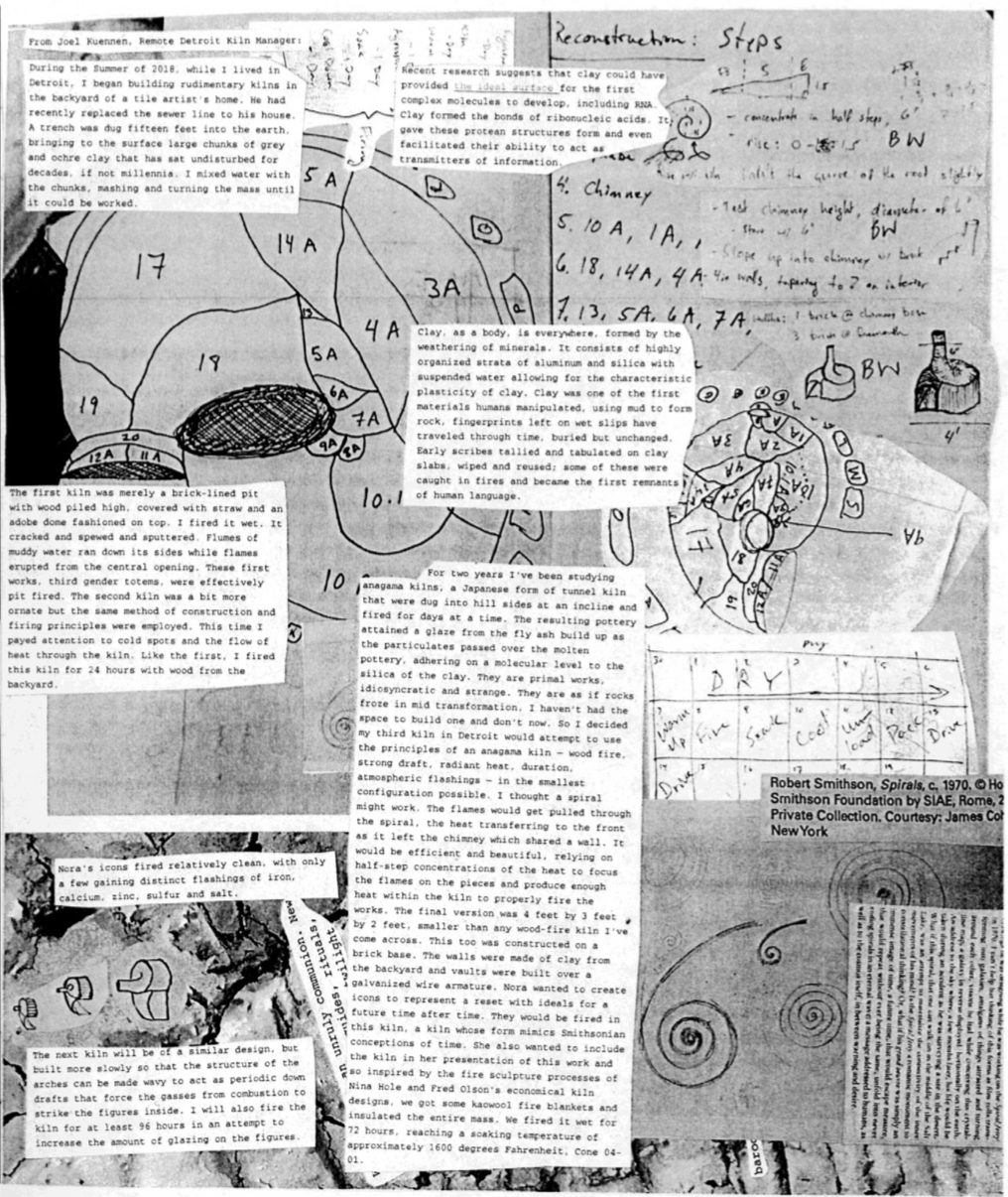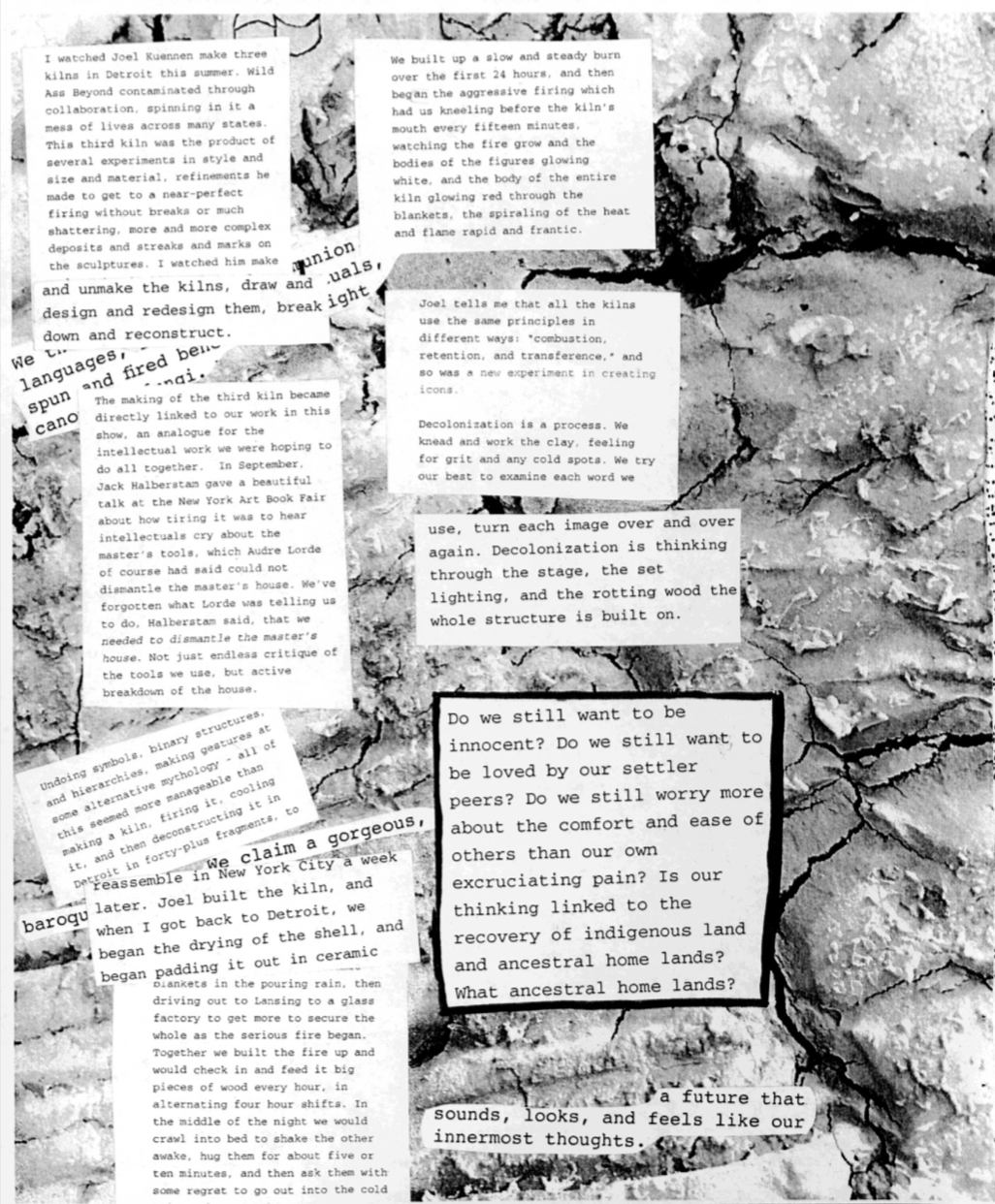|
Objects
Articles // Curation // Interviews // Social Practice // Objects // Academics // Exhibitions // Public Talks
The third in a series of rudimentary earthen kilns I made during the Summer of 2018 in Detroit redesigns one of humanity's oldest technologies. The spiral form of this kiln not only increases efficiency in the wood-burning process through using radiant, recycled heat, but its shape recalls Smithsonian conceptions of time and gestures at the kiln's ability to transform mud into rock, a process that would otherwise take millennia to accomplish. This kiln fired a series of works for Nora Khan that reimagined icons for reemerging, postapocalyptic identities. It was shown as part of A Wild Ass Beyond: Apocalypse RN at Performance Space, NY. Read about the process in the zine made by Nora Khan, Sondra Perry, American Artist and Caitlin Cherry....
View the presentation I gave at Bemis Center for Contemporary Art in Omaha, NE in April 2019 as their inaugural critic-in-residence. It introduces my interdisciplinary approach to making and how the kiln project developed in response to my writing and residency practices.
During the Summer of 2018 while I lived in Detroit, I began building rudimentary kilns in the backyard of a tile artist's home. He had recently replaced the sewer line to his house, a trench was dug fifteen feet into the earth, bringing to the surface large chunks of grey and ochre clay that had sat undisturbed for decades if not millennia. I mixed water with the chunks, mashing and turning the mass until it could be worked. The first kiln was merely a brick-lined pit with wood piled high, covered with straw and an adobe dome fashioned on top. I fired it wet. It cracked and spewed and sputtered, flumes of muddy water ran down its sides while flames erupted from the central opening. The works I lay at the bottom of the pit, third gender totems, were effectively pit fired by accumulating embers and pocked with calcium cankers and whisps of carbon. The second kiln was a bit more ornate but the same method of construction and firing principles were employed. This time I payed attention to cold spots and the flow of heat through the kiln. Like the first, I fired this kiln for 24 hours with wood from the backyard.
For two years I've been studying anagama kilns, a Japanese form of tunnel kiln that were dug into hill sides at an incline and fired for days at a time. The resulting pottery attained a glaze from the fly ash, built up as the particulates passed over the molten pottery, adhering calcium, phosphorous, potasium and magnesium on a molecular level to the silica of the clay. They are primal works, idiosyncratic and strange. They are as if rocks froze in mid transformation. I haven't had the space to build one and don't now. So I decided my third kiln in Detroit would attempt to use the principles of an anagama kiln – wood fire, strong draft, radiant heat, duration, atmospheric flashings – in the smallest configuration possible. I thought a spiral might work. The flames would get pulled through the spiral, the heat transferring to the front as it left the chimney which shared a wall. It would be efficient and beautiful, relying on half-step concentrations of the wdth of the kiln to focus the flames on the pieces and produce enough heat within the kiln to properly fire the works. The final version was 4 feet by 3 feet by 2 feet, smaller than any wood-fire kiln I've come across. This too was constructed on a brick base. The walls were made of clay from the backyard and vaults were built over a galvanized wire armature.
At the same time, Nora wanted to create icons to represent a reset with ideals for a future time after time. They would be fired in this kiln, a kiln whose form mimics Smithsonian conceptions of time. She also wanted to include the kiln in her presentation of this work and so inspired by the fire sculpture processes of Nina Hole and Fred Olson, we got some kaowool fire blankets and insulated the entire mass. We fired it wet for 72 hours, reaching a soaking temperature of approximately 1600 degrees Fahrenheit, Cone 012.
Nora's icons fired relatively clean, with only a few gaining distinct flashings of iron, calcium, zinc, sulfur and sodium. The next kiln will be of a similar design, but built more slowly to allow it to dry properly, the structure of the arches will be made wavy to act as periodic down drafts that force the gasses from combustion to strike the figures inside. I will also fire the kiln for at least 96 hours in an attempt to increase the amount of glazing on the figures.
From the zine accompanying A Wild Ass Beyond...: |

|

|
|